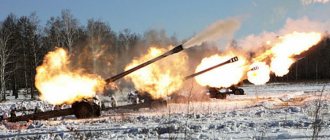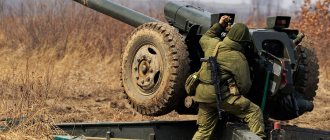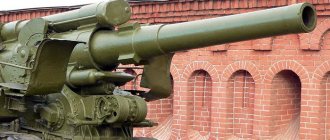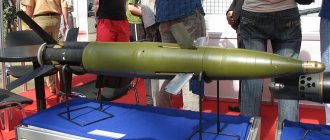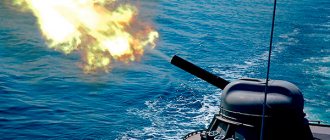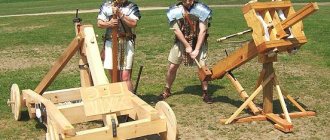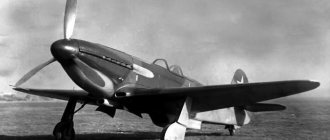3OF39 "Krasnopol"
"Krasnopol" - adjustable artillery ammunition of 152 or 155 mm caliber. Designed to hit armored targets and military installations with the first shot. The correction is carried out by aerodynamic control surfaces at the final stage of the flight according to the laser mark on the target. To increase the firing range, the projectile has a jet engine or a bottom gas generator. Developed aerodynamic surfaces provide planning to the target, increasing range and reducing cloud height restrictions. It is part of the Russian guided artillery weapon system, developed at the Tula Instrument Design Bureau. Export versions of the projectile are adapted to the corresponding systems of importing countries.
Serial production is carried out by Izhmash OJSC; the homing head (GOS) for the projectile is manufactured by LOMO.
Work on the creation of a guided 152-mm artillery projectile "Krasnopol" began in the late 1970s at KBP. The laser semi-active homing head for the projectile was developed by the Leningrad Optical-Mechanical Association, the production of the seeker was carried out by the Progress Research and Production Complex (now NVK Progress, Nezhin, Ukraine), the laser target designator-rangefinder 1D15 (or 1D20) was created by the Polyus Research Institute " On-board equipment - NIIFP.
Description
The Russian guided weapon system (GRAU index 2K25) includes a 3OF39 Krasnopol adjustable high-explosive fragmentation projectile of 152 mm caliber (used as part of the 3VOF64 and 3VOF93 separate-loading rounds), with a semi-active laser homing head 9E421, which receives a reflected signal from an illuminated target laser target designator-rangefinder 1D15 (1D20, 1D22). The complex may include a set of 1A35 shot synchronization tools and an R-159M radio station. Firing is carried out from Russian 152-mm artillery systems: D20, 2S3M Akatsiya, 2S19 Msta-S, 2A65 Msta-B.
For stowing in the fighting compartment of self-propelled guns, the 3OF39 projectile is structurally designed in the form of two compartments, joined before firing using a quick-screw connection:
— a projectile compartment, which includes a warhead (warhead), an accelerating engine (solid propellant motor) and a stabilizer unit; — control compartment, including the autopilot unit, seeker and nose unit.
Four retractable aerodynamic rudders are used as controls for the projectile in flight; the stabilizer block also has four retractable stabilizers.
The modified version 3OF39M is made as a monoblock, which simplifies preparation for shooting.
Friction bearings on the driving belts ensure low rotation speed of the projectile when fired from a standard rifled gun barrel. This is necessary for the normal operation of correction systems. To increase the charge, the ammunition body is made thin-walled. Maintaining the body geometry during overloads at the moment of firing is ensured by redistribution of the boost pressure of the powder gases. The optics of the homing head are covered with a protective casing (to protect against contamination and damage), which can be separated in flight.
Characteristics of the 152-mm howitzer gun D-20
A country:USSRType:Howitzer gunDate of issue:1950Calculation:8 peopleCaliber:152.4 mmLength:8.63 m (barrel length 5.2 m, i.e. 34.2 caliber)Width:2.4 mWeight:5.65 tons (in combat position)Rate of fire:up to 6 rounds per minuteFiring distance:24 km (active-missile projectile), 17.4 km (high-explosive fragmentation projectile)Initial projectile speed:655 m/sAmmunition:No informationThe history of the creation of the 152-mm howitzer gun D-20
The Soviet 152 mm D-20 gun-howitzer was created together with the 122 mm D-74 gun as a “hull duplex”. “Duplex” of two specialized, and at the same time assembled for the most part from the same blocks of artillery systems, made it possible, firstly, to solve the full range of tasks facing corps artillery, and secondly, it allowed to reduce costs and simplify repairs and operation, improve the supply of spare parts and training of artillery crews.
Both the 122-mm D-74 gun and the 152-mm D-20 gun-howitzer were designed immediately after the end of World War II at OKB-9 under the leadership of F. F. Petrov. The first prototype of the 122-mm D-74 cannon was manufactured by Plant No. 9 at the beginning of 1950, and on February 23, 1950 it was first tested by firing at the factory range.
With the D-20 it turned out more difficult - a monoblock 152-mm howitzer, originally called D-72, was ready in the same 1950. Only a slightly modified D-74 carriage was used as a carriage for it. But 2 years later (1952), the D-72 howitzer was reclassified into the D-20 howitzer gun (D is the factory index, and the number 20 is similar to the 152-mm ML-20 howitzer gun model 1937).
By 1953, 2 “hull duplex” batteries were manufactured, which began testing, which lasted until 1955. After completion of the tests, mass production of both guns was launched at , however, due to production delays, in fact, the first mass-produced D-74 and D-20 began to be mass-produced only in 1956.
Diagram of the 152-mm howitzer gun D-20
The D-20 became one of the first Soviet artillery systems capable of firing tactical nuclear and chemical ammunition, as well as the first 152 mm gun system with a semi-automatic wedge breech with vertical movement of the wedge. In the D-22 (2A33) modification, the D-20 howitzer gun is used as the main weapon of the 2S3 Akatsiya self-propelled gun.
In addition to the USSR/Russia, the howitzer gun was or is in service with three dozen countries, including: Azerbaijan, Afghanistan, Angola, Armenia, Belarus, Bulgaria, Hungary, Vietnam, Iraq, Iran, Yemen, Kazakhstan, China, North Korea, Congo, Moldova, Myanmar, Nicaragua, Poland, Romania, Serbia, Syria, Turkmenistan, Ukraine, Croatia, Sri Lanka, Finland, Yugoslavia. As of 2015, the D-20 howitzer guns of the Russian Army were put into reserve and withdrawn from service.
Soviet 152 mm gun-howitzer D-20
Design of the 152-mm howitzer gun D-20
The 152-mm howitzer gun D-20 is an artillery piece as part of field artillery, which combines the properties of a cannon and a howitzer (with a predominance of “cannon” properties). Compared to a cannon, a howitzer cannon has a shorter barrel length and larger barrel elevation angles. Compared to the howitzer, the howitzer gun has a longer firing range.
The barrel of the D-20 howitzer gun consists of a pipe, a breech, a clip and a muzzle brake. The shutter is vertical wedge, with semi-automatic mechanical type. The carriage of the D-20 howitzer gun was borrowed from the D-74 gun, differing only in the profile of the recoil brake spindle and the diameter of the front clip.
The recoil brake is hydraulic, spindle type, with a spring compressor, filled with steol-M. The knurl is hydropneumatic, filled with steol-M. The recoil and retractor brake cylinders are fixed in the barrel holder and roll back with it. Welded frames, box-type. To roll the gun over short distances, there are undercarriage rollers; the torsion bar suspension was not turned off when firing from the wheels. The main wheels are borrowed from a YAZ truck.
The lifting mechanism of the D-20 howitzer gun has one sector, providing a vertical aiming angle from -5 to +63 degrees. The rotating mechanism is a screw type, located on the left side of the gun, the horizontal guidance angle is 58 degrees. The balancing mechanism is pneumatic, push-type, and consists of two identical columns. A pallet is attached to the lower machine, which in the combat position served as a support for the system, while the wheels hang out.
Sighting devices consisted of an S-71 mechanical sight with an artillery panorama and an OP-2–97 direct fire sight.
Transportation of the 152 mm D-20 gun-howitzer
KM-2 "Krasnopol-M2"
155-mm version of the Krasnopol-M guided artillery projectile (to NATO standards). Includes an adjustable high-explosive fragmentation projectile K155M of 155 mm caliber, with semi-active homing to a target illuminated by a laser. Designed to destroy stationary and moving armored and unarmored targets and engineering structures at a distance of up to 25 km, with the first shot. The method of destruction is from above, along a takeoff-dive trajectory.
Supplied to India and China, produced under license in China. For the Krasnopol-M complex, CILAS (France) developed a laser target designation system DHY307; in 2001, to confirm its compatibility with Krasnopol, firing tests using DHY307 were carried out in France.
Modifications and variants of the 152 mm D-20 gun-howitzer
- D-22 (Russia) — A gun for the 2S3 Akatsiya self-propelled gun.
- Type 66 (China) - licensed Chinese version of the D-20.
- D-20M "Khitin" (Russia) - a modernized version with an automatic rammer, increasing the rate of fire to 7-8 rounds/min. The modification is oriented for export.
- Type 83 (China) - Chinese version of the 2S3 Akatsiya self-propelled gun, with a Type 66 gun.
- A411 (Romania) - 152 mm M1981 towed gun-howitzer copying the D-20, but using its own 152 mm ammunition, which (with a barrel length of 20.5 calibers) has a maximum range of 17.2 km.
Shot from a 152 mm D-20 howitzer gun
• Artillery Directory • Artillery of the same period •
Source: compilation based on publicly available information on the Internet
Photo Giatsint-B
2A36 in tow behind the KamAZ-63501AT “Bear” tractor
Similar
SAU 2S7 Pion (2S7M Malka) performance characteristics.
Caliber. Dimensions. Firing range of MLRS BM-21 Grad. Damage area. Rockets. Caliber. Story
120-mm mortar 2B11 complex 2S12 Sani TTX. Firing range. Weight
Mortar 2B9M Vasilek 82 mm Rate of fire. Firing range. Weight
Self-propelled gun 2S3 Akatsiya 152 mm. Firing range. Dimensions. Weight. Engine
SAU 2S1 Gvozdika 122 mm Firing range. Dimensions. Device. Weight
Gun 2A36 Giatsint-B 152 mm. Firing range. Dimensions. Device
MLRS 9K58 Smerch Damage area. Rockets. Caliber. Story
MT-12 Rapier gun. Firing range. Story. Dimensions
Howitzer D-30 122-mm performance characteristics. Firing range. Dimensions. Weight
2S4 Tulip self-propelled mortar 240 mm performance characteristics. Dimensions. Firing range. Weight
Self-propelled gun 2S35 Koalitsiya-SV 152-mm performance characteristics. Firing range. Dimensions. Weight
Howitzer Msta-B (2A65) 152 mm. Firing range. Dimensions. Weight. Ammunition
Self-propelled gun 2S9 Nona-S 120 mm performance characteristics. Firing range. Dimensions. Weight. Armament
AT-T heavy artillery tractor. TTX. Dimensions. Engine. Story
SAU 2S19 Msta-S 152 mm Dimensions. Speed. Engine. Story
MLRS 9K57 Hurricane Damage area. Rockets. Caliber. Story
TOS-1 Buratino (TOS-1A Solntsepek) performance characteristics. Damage area
Divisional gun ZIS-3 76 mm. TTX. Firing range. Dimensions. Weight
Howitzer gun D-20 152 mm performance characteristics. Firing range. Dimensions. Weight
Howitzer M-30 model 1938 122-mm performance characteristics. Firing range. Dimensions. Weight
Self-propelled gun 2S5 Giatsint-S 152 mm performance characteristics. Firing range. Armament. Dimensions. Weight
Self-propelled gun Ferdinand (Elephant) performance characteristics. Reservation. Weight. Dimensions
Self-propelled gun SU-100. TTX. Armament. Dimensions. Shells. Weight. Speed
Self-propelled gun Sturmtiger caliber 380 mm. TTX. Armament. Shells. Reservation. Dimensions
203-mm howitzer B-4 model 1931 performance characteristics. Weight. Ammunition. Dimensions
Self-propelled gun SU-152 St. John's wort 152 mm performance characteristics. Shells. Firing range. Dimensions. Weight
Gun M-46 130-mm performance characteristics. Firing range. Dimensions. Weight
Demining installation UR-77 Meteorite TTX. Armament. Dimensions
MLRS 9K51M Tornado-G. Rockets. TTX. Firing range. Dimensions
SAU 2S31 Vienna 120 mm. Firing range. Story. Dimensions. Weight
German self-propelled gun StuG III. Modifications. Dimensions. Armament. Weight
Guided projectile Krasnopol. TTX. Firing range. Dimensions. Price
Mortar Karl 600 mm and 540 mm performance characteristics. Firing range. Weight. Dimensions
Big Bertha 420 mm gun. TTX. Weight. Dimensions. Ammunition
Self-propelled gun SU-76. TTX. Dimensions. Reservation. Weight. Story
SAU 2S23 Nona-SVK 120-mm performance characteristics. Armament. Range and accuracy of fire. Dimensions
SAU 2A3 Condenser-2P caliber 406 mm Firing range. Armament. Dimensions. Weight
Mortar M-160 caliber 160-mm performance characteristics. Firing range. Ammunition. Dimensions
Airborne self-propelled gun ASU-57. Armament. TTX. Dimensions. Weight. Booking
Artillery complex A-222 Bereg 130 mm. TTX. Firing range. Ammunition
Howitzer BR-18 caliber 305 mm TTX. Firing range. Weight
152 mm howitzer D-1. Firing range. Dimensions. Weight. Device
Mortar M-240 caliber 240 mm. Firing range. Dimensions. Weight
Self-propelled gun SU-85. Ammunition. Reservation. Dimensions. Weight. Engine
Counter-battery radar Zoo-1 (1L219M). Range of control of firing positions. Device
SAU 2S25 Sprut-SD. Caliber. Story. Dimensions. Weight. Engine
Self-propelled gun 2S34 Hosta 120 mm. TTX. Dimensions. Firing range. Armament. Weight
Self-propelled gun ASU-85. Armament. Dimensions. Reservation. Weight
280-mm mortar Br-5 model 1939 Dimensions. Weight. Ammunition
Self-propelled gun 2A45M Sprut-B. TTX. Speed. Engine. Weight
Belarusian MLRS BelGrad. TTX. Firing range. Ammunition. Dimensions
S-23 cannon 180 mm caliber. Ammunition. Weight. Dimensions. Firing range
Self-propelled gun SAU SU-122. Dimensions. Armament. Reservation. Weight
Self-propelled gun Jagdpanther. Weight. Reservation. Dimensions. Armament
Multi-barreled self-propelled gun M50 Ontos. TTX. Armament. Dimensions. Booking
D-74 cannon 122 mm caliber. Firing range. Dimensions. Weight
Artillery tractor YA-12. Dimensions. Weight. Load capacity. Engine
Artillery tractor T-20 Komsomolets. Armament. Reservation. Dimensions. Weight
SAU ISU-122. Armament. Dimensions. Weight. Booking
RPU-14 (8U38) - rocket launcher
MLRS BM-24 (T) 240 mm. Firing range. Dimensions. Weight. Engine
2K32 Deva - 82-mm self-propelled mortar system
Artillery tractor Comintern. Load capacity. Dimensions. Weight. Engine
Self-propelled gun SU-122-54. Reservation. Dimensions. Weight. Firing range
MLRS BM-14-16. Armament. Dimensions. Weight. Firing range
Self-propelled gun Nashorn (Rhinoceros). Armament. Dimensions. Weight. Booking
BR-2 gun caliber 152 mm. Firing range. Dimensions. Weight
Self-propelled howitzer self-propelled gun PzH 2000. Firing range. Dimensions. Weight
BR-17 cannon 210 mm caliber. Weight. Firing range. Rate of fire
Self-propelled gun Vespe 105 mm. Armament. Dimensions. Reservation. Weight
Wheeled self-propelled gun GAZ-68 (KSP-76). Armament. Dimensions. Weight. Engine
Self-propelled gun Brummbar 150 mm. Armament. Dimensions. Weight. Booking
Heavy self-propelled gun SU-14. Reservation. Dimensions. Weight. Engine
Self-propelled gun SU-5. Armament. Reservation. Dimensions. Weight
Self-propelled gun AT-1. Reservation. Dimensions. Weight. Engine
Self-propelled gun SU-12. Armament. Reservation. Dimensions. Weight
